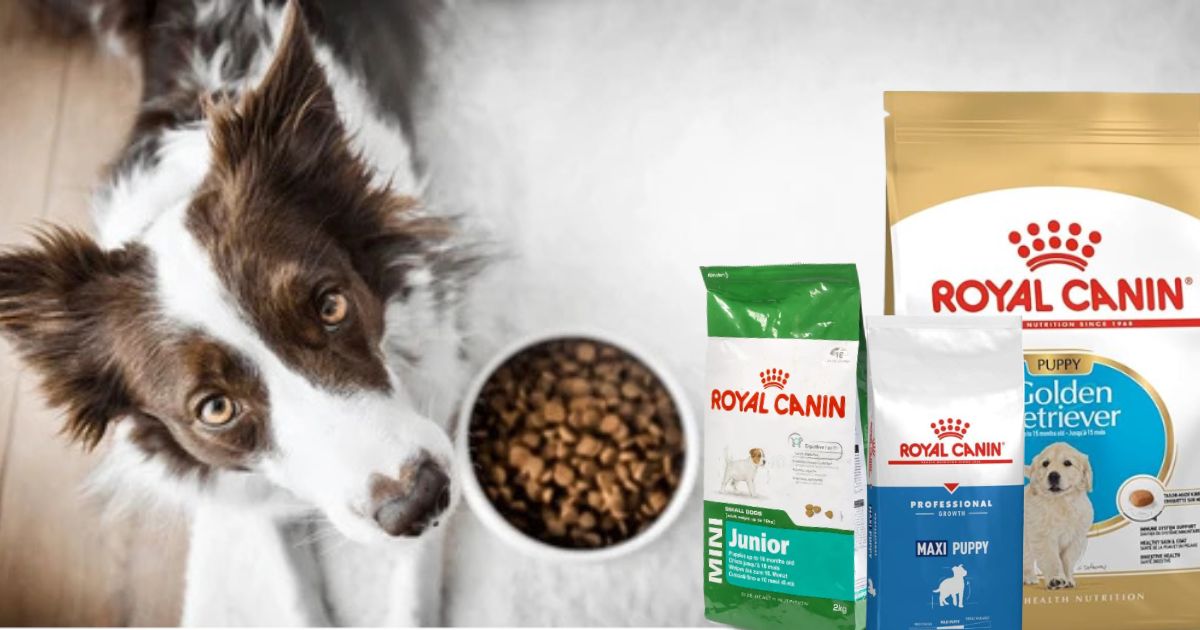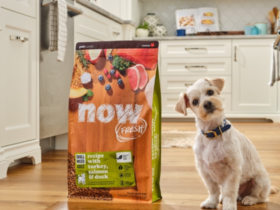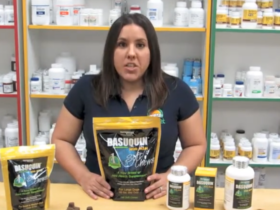Finding the right food for a dog with skin allergies can be a puzzle. Many options promise relief, but not all deliver.
Owners know the struggle of watching their furry friends itch and scratch without relief. The quest for the best dry dog food for skin allergies begins with understanding what triggers these reactions. The right kibble can make all the difference.
It can ease your dog’s discomfort and lead to a happier, healthier life. Our pets deserve the best, and when it comes to allergies, the solution is often found in their bowl. The best dry dog food for skin allergies will contain high-quality ingredients that nourish without causing irritation. This article will guide you through the maze of options to find a food that will soothe your dog’s skin and keep their tail wagging.
Introduction To Skin Allergies In Dogs
Itchy, flaky, and irritable skin in dogs often points to skin allergies. Dry dog food tailored for these conditions can help. Understanding the root causes and symptoms is the first step to relief.
Common Causes
- Environmental allergens like pollen or dust
- Food sensitivities to specific ingredients
- Flea bites or parasite infections
- Underlying genetic factors
Signs And Symptoms
Dogs show they’re suffering through:
- Constant scratching or licking
- Red, inflamed skin
- Hot spots or bald patches
- Dry, flaky skin or scabs
Importance Of Diet For Allergic Dogs
Dogs with allergies need special care. Their diet plays a big role. The right food can ease their symptoms. Let’s explore how diet affects skin health and the perks of a specialized diet.
Connection Between Diet And Skin Health
Dogs’ skin reacts to what they eat. Some foods cause bad reactions. These reactions can make their skin itchy and red. Feeding them the right food helps keep their skin healthy. This means fewer itchy spots and happier dogs.
Benefits Of A Specialized Diet
A diet made for allergic dogs does wonders. It cuts down on allergic reactions. This leads to less scratching and discomfort. Their coats become shiny and strong. Overall, they feel better. This shows how important the right food is for dogs with allergies.
Key Ingredients To Look For
Finding the right dry dog food for skin allergies can be a game-changer for your pet’s comfort and health. It’s crucial to know the key ingredients that can help alleviate these allergies. The best dry dog food for skin allergies will include specific components aimed at reducing allergic reactions. Let’s dive into what these ingredients are and why they’re important for your furry friend.
Hypoallergenic Components
First up, hypoallergenic components. These are critical in any dry dog food for skin allergies. They help minimize the risk of an allergic response. Ingredients like hydrolyzed proteins break down so the immune system doesn’t recognize them as allergens. This means less itching and discomfort for your dog.
Essential Fatty Acids
Next, let’s talk about essential fatty acids. Omega-3 and Omega-6 are vital for skin health. They work to reduce inflammation and support a strong skin barrier. This can lead to less scratching and a shinier coat. Look for foods with fish oil or flaxseed to give your dog these beneficial oils.
Ingredients To Avoid
Dogs with skin allergies need special care in their diet. Certain ingredients can worsen their condition. Let’s explore which ones to avoid for your furry friend’s well-being.
Allergenic Food Triggers
Common culprits behind dog skin allergies are specific proteins. Beef, dairy, wheat, and chicken top this list. Dogs may react to these with itchy skin. Choose dog foods without these proteins. Look for novel protein sources instead.
Artificial Additives And Preservatives
Artificial colors, flavors, and preservatives can trigger allergies. These include butylated hydroxyanisole (BHA) and butylated hydroxytoluene (BHT). Natural preservatives are better for sensitive dogs. Examples include tocopherols (vitamin E) and ascorbic acid (vitamin C).
Top Picks For Dry Dog Food
Choosing the right dry dog food for pets with skin allergies is crucial. Our top picks aim to ease your search. These options focus on reducing allergic reactions. They provide balanced nutrition too.
Single Protein Sources
Dogs with skin allergies often react to certain proteins. Foods with one protein source can help. This simplifies their diet. It makes identifying allergens easier. Look for foods listing a single meat, like chicken or salmon, as their main ingredient.
- Chicken-based food – Good for muscle growth.
- Salmon-based food – Supports skin health.
Grain-free Options
Some dogs are allergic to grains. Grain-free dog foods avoid common grains like wheat, corn, and rice. Instead, they use ingredients like sweet potatoes. These provide energy without the risk of grain allergies.
| Brand | Key Ingredient | Grain-Free |
| Paws & Pals | Sweet Potato | Yes |
| Happy Tails | Pumpkin | Yes |
Both single protein sources and grain-free options can benefit dogs with skin allergies. They reduce potential allergens in your dog’s diet. Always consult a vet before changing your dog’s diet.
Reading Dog Food Labels
Choosing the right dry dog food for skin allergies means careful label examination. Pet owners must understand ingredients and spot hidden allergens. Knowledge is key to a healthy diet for sensitive pets.
Understanding Ingredient Lists
Dog food labels can be complex. Start at the top; the first items listed are the most abundant. Look for whole foods and quality protein sources. Avoid by-products and fillers. These can irritate your dog’s skin. Names should be recognizable and simple.
Identifying Hidden Allergens
Common allergens are not always obvious. Wheat and soy hide under various names. Even ‘natural flavors’ can be misleading. Learn the synonyms used for common allergens. It ensures you don’t miss sneaky ingredients. Your dog’s skin will thank you.
Transitioning To A New Food
Finding the right dry dog food for skin allergies can be a relief for your furry friend. But, switching their food needs care. Let’s talk about Transitioning to a New Food.
Gradual Introduction
Start by mixing a small amount of the new food with their current one. Use a mix of 25% new food and 75% old food. Over 7 to 10 days, slowly increase the new food amount. Each day, the mix should change a bit more towards the new food. This helps your dog adjust without stomach issues.
- Day 1-3: 75% old food, 25% new food
- Day 4-6: 50% old food, 50% new food
- Day 7-9: 25% old food, 75% new food
- Day 10: 100% new food
Monitoring Your Dog’s Response
Watch your dog closely. Look for signs of improvement or any new issues. Signs to watch for include:
- Energy levels
- Skin condition
- Stomach upset
If problems appear, talk to a vet. They can help adjust the food change or find a better option.
Remember, each dog is unique. What works for one might not work for another. Patience and attention are key during this transition.

Credit: redskelton-gallery.com
Home Remedies And Supplements
Dry dog food for skin allergies can benefit from home remedies and supplements. These additions can soothe and improve your pet’s skin health. Let’s explore these options further.
Natural Skin Soothers
Natural ingredients can calm irritated skin. Oatmeal baths are a classic remedy. They ease itching and reduce inflammation. Coconut oil also works wonders. It moisturizes dry skin and reduces allergic reactions. Aloe vera is another gentle soother for sore skin.
- Oatmeal baths – Mix natural oatmeal with water. Apply to your dog’s coat. Rinse after 10 minutes.
- Coconut oil – Rub a small amount onto affected areas. It hydrates and protects.
- Aloe vera – Use pure gel on itchy spots. It cools and heals the skin.
Boosting Skin Health Through Supplements
Supplements can also support skin health. Omega-3 fatty acids are key. They fight inflammation and promote a glossy coat. Vitamin E protects skin cells. Probiotics balance gut health, which is linked to skin health.
| Supplement | Benefits |
| Omega-3 fatty acids | Reduce inflammation, improve coat texture |
| Vitamin E | Antioxidant that protects skin |
| Probiotics | Support gut health, may help alleviate allergies |
When To Consult A Vet
Choosing the right dry dog food for pets with skin allergies is vital. Consult a vet for guidance on the best options tailored to your dog’s needs.
When to Consult a Vet Finding the best dry dog food for skin allergies often starts at home. Yet, there are times when a vet’s guidance is crucial. Dogs with skin allergies may react differently to various treatments. A vet can pinpoint the cause. They can also suggest the best food options.
Persistent Symptoms
Does your dog still scratch after switching foods? Their skin allergy might need more than a diet change. Redness, itching, and hair loss that won’t stop are signs to see a vet. They will check for other health issues.
Professional Dietary Advice
A vet has the knowledge to recommend specific dog foods. They understand which ingredients may trigger allergies. A vet can create a custom diet plan for your dog. This plan will avoid allergens and nourish their skin. Trust a professional to help your furry friend feel better.

Credit: www.nbcnews.com
Success Stories
Dog lovers often struggle with their furry friends’ skin allergies. The right food can make all the difference. Here, we share real-life success stories from pet owners who found the best dry dog food for skin allergies.
Testimonials From Pet Owners
Countless tails wag thanks to these foods. Here’s what happy owners say:
- Jenny’s itch-free Jack Russell: “Two months in, no more scratching!”
- Max’s glossy coat: “Friends can’t stop admiring his healthy fur.”
- Bella’s newfound energy: “She’s playful again, like a puppy!”
Before And After Scenarios
Pictures speak louder than words. Witness the transformations:
| Before | After |
| Dull fur, red spots | Shiny coat, clear skin |
| Constant licking, biting | More play, less scratching |
| Low spirit, less active | Bright eyes, full of life |
These stories are just a glimpse of the impact. The right dry dog food transforms lives.
Faqs On Dog Food For Skin Allergies
Dog owners often face the challenge of finding the right food for pups with skin allergies. This section answers common questions and offers tips on selecting and serving the best dry dog food to support your furry friend’s skin health.
Choosing The Right Food
Many dogs have food sensitivities that affect their skin. The key is to pinpoint the allergen. Foods with limited ingredients are best. They make it easier to isolate and remove the problem. Choose a formula with novel proteins and carbohydrates. Examples include venison and sweet potato. These are less likely to cause reactions. Always opt for high-quality brands. They use better ingredients, which can help reduce allergy symptoms.
Dealing With Picky Eaters
Some dogs are fussy about their food, especially when diets change. Start by mixing a small amount of the new food with their current one. Gradually increase the new food over a week. This helps your dog adjust. Picky eaters need tempting textures and flavors. Look for foods with real meat and natural juices. They often appeal more to a dog’s palate. Keep meals consistent. Dogs can learn to love their new, allergy-friendly food over time.

Credit: mustang-seversk.ru
Frequently Asked Questions
What Causes Skin Allergies In Dogs?
Skin allergies in dogs are primarily caused by three factors: environmental allergens like pollen or mold, food allergies, particularly to certain proteins, and flea bites, which can trigger allergic dermatitis. Identifying the specific cause is crucial for effective treatment and dietary management.
How Does Diet Affect Dog Skin Allergies?
Diet plays a significant role in managing dog skin allergies. Certain ingredients in dog food, such as specific proteins, corn, wheat, or soy, can trigger allergic reactions. Switching to a hypoallergenic or limited-ingredient diet can alleviate symptoms by avoiding these triggers.
What Ingredients To Look For In Dog Food For Skin Allergies?
When selecting dog food for skin allergies, look for foods containing novel proteins (like duck or venison), omega-3 fatty acids to reduce inflammation, and limited ingredients to minimize exposure to potential allergens. Avoid common allergens like beef, chicken, corn, wheat, and soy.
How To Transition Your Dog To A New Food For Allergies?
Transitioning your dog to a new food should be gradual, over 7-10 days. Start by mixing a small amount of the new food with the current food. Gradually increase the new food’s proportion while decreasing the old food, monitoring your dog’s response to ensure tolerance.
Conclusion
Choosing the right dry dog food for skin allergies can make a big difference. Your furry friend deserves comfort and health. We’ve shared top picks for dogs with sensitive skin. Each option is packed with nutrients and free from common irritants.
Always consult your vet before switching your dog’s diet. They can guide you based on your pet’s specific needs. Remember, a happy dog starts with what’s in their bowl. So, pick the best for your pup and watch them thrive.
Dogs with sensitive skin need special care, and food plays a big role. The right diet can ease their discomfort and improve their health.
Sensitive skin in dogs can cause itching, redness, and irritation. Choosing the right dog food can help manage these issues. This blog post will explore the causes of sensitive skin in dogs and the best ingredients to look for in their food.
We will also discuss top dog food brands for sensitive skin and how a balanced diet can benefit your furry friend. You’ll learn about the pros and cons of grain-free and grain-inclusive options, the importance of omega fatty acids, and how to identify if your dog needs special food. Let’s dive into how you can help your dog feel better and stay healthy.

Credit: www.farmandfleet.com
Understanding Sensitive Skin In Dogs: Causes And Symptoms
Sensitive skin in dogs can be caused by allergies, diet, or environmental factors. Common symptoms include itching, redness, and flaky skin. Choosing the right dog food can help manage these issues effectively.
Sensitive skin in dogs can be a real concern for many pet owners. It often leads to constant itching, scratching, and discomfort for your furry friend. Understanding the causes and symptoms can help you take better care of your dog’s skin.
Common Causes Of Sensitive Skin In Dogs
Several factors can cause sensitive skin in dogs. Here are some common ones:
- Allergies: Dogs can be allergic to certain foods, pollen, or dust.
- Parasites: Fleas, ticks, and mites can irritate the skin.
- Environmental Factors: Extreme weather conditions, such as heat or cold, can affect the skin.
- Chemical Exposure: Harsh shampoos or cleaning products might cause reactions.
Recognizing Symptoms Of Sensitive Skin
Noticing the signs early can prevent further discomfort. Look for these symptoms:
- Constant Scratching: Frequent itching can be a sign.
- Redness and Inflammation: Visible skin irritation.
- Bald Patches: Hair loss in specific areas.
- Dry, Flaky Skin: Flakes similar to dandruff might appear.
- Rashes or Bumps: Small lesions or raised areas on the skin.
Dietary Factors
Diet plays a crucial role in skin health. Poor nutrition can lead to skin issues. Ensure your dog’s diet includes:
- Omega-3 Fatty Acids: Found in fish oil, it helps reduce inflammation.
- Vitamin E: Supports skin health and repair.
- High-Quality Protein: Essential for healthy skin and coat.
- Limited Ingredients: Fewer ingredients reduce the risk of allergies.
Importance Of Regular Vet Visits
Regular check-ups can prevent many skin issues. A vet can:
- Identify Allergies: Test and determine specific allergens.
- Recommend Treatments: Provide appropriate medication or dietary changes.
- Monitor Skin Health: Regularly check for any skin problems.
- Offer Advice: Tips on grooming and skincare.
Understanding these aspects helps you manage your dog’s sensitive skin better. Careful observation and proper care ensure your dog stays happy and healthy.
Top Ingredients To Look For In Dog Food For Sensitive Skin
Dog food for sensitive skin should contain ingredients like salmon, sweet potatoes, and flaxseed. These help reduce itching and inflammation. Always check for these key components.
Dogs with sensitive skin need special care, and their diet plays a crucial role. Choosing the right food can help alleviate their discomfort. Let’s explore some top ingredients that can make a difference.
Omega-3 Fatty Acids
Omega-3 fatty acids are essential for healthy skin and coat. They help reduce inflammation and soothe itchy skin.
- Fish oil: Rich in omega-3s, supports skin health.
- Flaxseed: Another good source of omega-3s, promotes a healthy coat.
Limited Ingredients
A limited ingredient diet (LID) can minimize exposure to allergens. It includes fewer components, making it easier to pinpoint issues.
Novel Proteins
Novel proteins can be beneficial for dogs with sensitivities. These proteins come from less common sources, reducing the risk of allergies.
- Duck: A unique protein source, gentle on the stomach.
- Venison: Another uncommon protein, helps manage skin reactions.
Whole Grains
Whole grains provide necessary nutrients and fiber. They support overall health and help maintain a balanced diet.
Probiotics
Probiotics support gut health, which is linked to skin health. A healthy gut can improve skin conditions.
- Yogurt: Contains probiotics, promotes good digestion.
- Special supplements: Designed for dogs, support skin and coat health.
Antioxidants
Antioxidants protect cells from damage and support the immune system. They help keep the skin healthy and resilient.
No Artificial Additives
Avoiding artificial additives is crucial. These can trigger allergies and worsen skin conditions.
- Artificial colors: Can cause adverse reactions.
- Preservatives: May contribute to skin issues.
By focusing on these key ingredients, you can help your dog lead a more comfortable and itch-free life.
Best Dog Food Brands For Sensitive Skin: Our Top Picks
Discovering the best dog food brands for sensitive skin can help your furry friend feel better. Our top picks include gentle, nutritious options. These brands focus on high-quality ingredients to soothe and nourish your dog’s skin.
Choosing the right dog food for sensitive skin can be a game-changer for your furry friend. Sensitive skin can cause discomfort, and selecting the right diet can help. Here are our top picks for the best dog food brands that cater to dogs with sensitive skin.
Blue Buffalo Basics
Blue Buffalo Basics offers high-quality, limited-ingredient recipes. These are perfect for dogs with sensitive skin.
- No chicken or beef: Reduces common allergens.
- Single animal protein source: Eases digestion.
- Added omega-3 and omega-6: Promotes a healthy coat.
Hill’s Science Diet
Hill’s Science Diet is known for its vet-recommended formulas. Their sensitive skin recipe is no exception.
This brand focuses on gentle ingredients to minimize skin irritation. It includes vitamins and fatty acids for skin and coat health. It’s a great option for dogs prone to allergies.
Purina Pro Plan Sensitive Skin & Stomach
Purina Pro Plan caters to dogs with sensitive skin and stomachs. Their formula is crafted to support overall health.
- Salmon as the first ingredient: Rich in omega fatty acids.
- No corn, wheat, or soy: Avoids common allergens.
- Added prebiotics: Supports digestive health.
Royal Canin Veterinary Diet
Royal Canin offers a specialized veterinary diet. It targets dogs with specific dietary needs.
This brand provides balanced nutrition with limited ingredients. It’s designed to support dogs with skin sensitivities. You might need a vet prescription to purchase it.
Nutro Limited Ingredient Diet
Nutro Limited Ingredient Diet simplifies your dog’s food to just a few ingredients. This helps to avoid allergens.
- No artificial flavors or preservatives: Reduces potential irritants.
- Non-GMO ingredients: Ensures high-quality nutrition.
- Lamb or venison options: Provides alternative protein sources.
Choosing the right dog food can make all the difference. These brands offer great options for dogs with sensitive skin. Always consult with your vet before making changes to your pet’s diet.
How A Balanced Diet Can Help Manage Your Dog’s Sensitive Skin
Feeding your dog a balanced diet can significantly improve sensitive skin. Quality dog food helps reduce irritation and itchiness. Proper nutrition supports overall skin health.
Nutrient-rich Ingredients
A balanced diet with nutrient-rich ingredients can greatly help manage your dog’s sensitive skin. High-quality proteins, healthy fats, and essential vitamins play a key role in maintaining skin health.
Omega-3 And Omega-6 Fatty Acids
Omega-3 and Omega-6 fatty acids are vital for skin health. These fatty acids help reduce inflammation and keep the skin moisturized.
- Rich sources: Fish oil and flaxseed oil.
- Benefits: Reduce itching and dry skin.
High-quality Proteins
High-quality proteins are essential for your dog’s overall health. They aid in the repair and growth of skin cells.
Antioxidants
Antioxidants are crucial for protecting the skin from damage. They help combat free radicals and support the immune system.
- Common sources: Blueberries, sweet potatoes, and carrots.
- Skin benefits: Protect against environmental damage.
Avoiding Allergens
Identifying and avoiding common allergens can help manage sensitive skin. Food allergies often cause skin issues in dogs.
Proper Hydration
Proper hydration is key to keeping your dog’s skin healthy. Water helps maintain skin elasticity and prevents dryness.
- Daily water intake: Ensure fresh water is available at all times.
- Moisture-rich foods: Include wet dog food in their diet.
Regular Vet Check-ups
Regular vet check-ups are crucial in managing your dog’s skin health. Your vet can identify any underlying issues.
Consistent Feeding Schedule
A consistent feeding schedule helps maintain your dog’s digestive health. It also ensures they receive balanced nutrients regularly.
- Regular meals: Feed your dog at the same times each day.
- Portion control: Avoid overfeeding to maintain a healthy weight.
Grain-free Vs. Grain-inclusive Dog Food For Sensitive Skin
Choosing the right dog food for sensitive skin can make a big difference. Grain-free options might help reduce allergies, while grain-inclusive foods often provide essential nutrients. Always consult a vet to find the best diet for your pet’s specific needs.
Dogs with sensitive skin need special care, including the right diet. Choosing between grain-free and grain-inclusive dog food can be challenging. Each has its benefits and potential drawbacks.
Grain-free Dog Food For Sensitive Skin
Grain-free dog food omits grains like wheat, corn, and rice. This choice can be beneficial for some dogs.
- Fewer Allergens: Grain-free foods often have fewer allergens. This can reduce skin issues.
- High-Quality Ingredients: Typically, these foods contain high-quality meats. They offer better protein sources.
- Improved Digestion: Many dogs digest grain-free food better. This can lead to healthier skin.
Grain-inclusive Dog Food For Sensitive Skin
Grain-inclusive dog food contains grains. These grains can be beneficial for some dogs with sensitive skin.
Grains can provide necessary nutrients. They are often rich in vitamins and minerals. Additionally, grains can be good sources of fiber, aiding in digestion.
Choosing The Right Option For Your Dog
Deciding between grain-free and grain-inclusive depends on your dog’s unique needs.
- Veterinarian Advice: Consult your vet. They can offer personalized recommendations.
- Observe Symptoms: Watch for signs of allergies. This can help in identifying the best diet.
- Trial and Error: Sometimes, finding the right food takes time. Try different options to see what works.
Key Considerations For Dog Food
When selecting dog food for sensitive skin, keep these factors in mind:
- Ingredient List: Check for common allergens. Avoid foods with lots of fillers.
- Quality of Ingredients: High-quality ingredients are crucial. They support overall health.
- Nutritional Balance: Ensure the food meets all nutritional needs. Balanced diets promote better skin health.
By carefully considering these points, you can help your dog lead a happy, healthy life.
The Role Of Omega Fatty Acids In Skin Health For Dogs
Omega fatty acids in dog food help maintain healthy skin for dogs with sensitive skin. They reduce inflammation and promote a shiny coat.
Dogs with sensitive skin can benefit from certain nutrients in their diet. One key nutrient is omega fatty acids. These essential fats play a crucial role in maintaining healthy skin.
What Are Omega Fatty Acids?
Omega fatty acids are types of fats needed for overall health. They come in two main types:
- Omega-3: Found in fish oil and flaxseed oil.
- Omega-6: Found in poultry fat and plant oils.
Benefits Of Omega Fatty Acids For Dogs
Omega fatty acids offer several benefits for dogs’ skin health. Here are some key points to consider:
- Reduces inflammation: Helps soothe irritated skin and reduce redness.
- Maintains moisture: Keeps the skin hydrated and prevents dryness.
- Supports skin barrier: Strengthens the skin’s natural barrier against allergens.
Sources Of Omega Fatty Acids In Dog Food
Various ingredients in dog food provide omega fatty acids. Common sources include:
- Fish oil: Rich in omega-3, commonly found in high-quality dog foods.
- Flaxseed oil: Another good source of omega-3, often used in natural dog foods.
- Chicken fat: Provides omega-6, essential for balanced nutrition.
- Sunflower oil: Contains omega-6, supporting skin health.
How To Choose The Right Dog Food
Selecting the right dog food ensures your pet gets enough omega fatty acids. Consider these factors:
- Check the label: Look for foods with listed sources of omega-3 and omega-6.
- Quality ingredients: Opt for dog foods with natural, high-quality fat sources.
- Balance: Ensure a good balance of omega-3 and omega-6 for optimal skin health.
Frequency Of Omega Fatty Acids Intake
Regular intake of omega fatty acids is vital for dogs with sensitive skin. Here’s how often they should be consumed:
- Daily feeding: Most commercial dog foods provide these fats in daily servings.
- Supplements: Consider omega supplements if food intake is insufficient.
Potential Side Effects
While beneficial, omega fatty acids can have side effects if overconsumed. Possible issues include:
- Weight gain: Excess fats can lead to obesity in dogs.
- Digestive upset: Too much oil might cause diarrhea or vomiting.
Proper dosage is key to avoiding these problems.
Omega fatty acids are crucial for dogs with sensitive skin. They help reduce inflammation, maintain moisture, and support the skin barrier. Choose dog food with high-quality sources of these fats, and ensure a balanced intake to keep your furry friend healthy and comfortable.
Signs Your Dog May Need Food For Sensitive Skin
Does your dog itch or have dry, flaky skin? These could be signs they need food for sensitive skin. Switching their diet may help improve their comfort and health.
Sensitive skin can be a tough issue for dogs. It can make them uncomfortable and irritable. Knowing the signs of sensitive skin can help you choose the right food for your furry friend.
Excessive Scratching And Licking
Dogs with sensitive skin often scratch and lick more than usual.
- Constant scratching: This can lead to skin injuries.
- Frequent licking: It can indicate irritation or allergies.
- Chewing paws: A sign of discomfort or itchiness.
Red Or Inflamed Skin
Red or inflamed skin is a common sign of sensitivity.
Watch out for areas that look red or swollen. This can be a reaction to food or environmental factors. In severe cases, the skin may even appear raw or bleeding.
Hair Loss Or Bald Patches
Hair loss can be alarming and is often a sign of skin issues.
- Bald spots: Areas without hair can appear suddenly.
- Thinning fur: This can indicate an underlying issue.
- Excess shedding: More fur loss than normal can point to problems.
Digestive Issues
Sometimes, skin problems come with digestive issues.
- Diarrhea: This can signal food allergies.
- Vomiting: Another sign of food sensitivity.
- Poor appetite: Your dog may eat less due to discomfort.
Hot Spots
Hot spots can develop quickly and are a sign of sensitive skin.
These are moist, red areas that can be very painful. They often result from constant scratching or licking. Hot spots need prompt attention to prevent infection.
Recognizing these signs can help you choose better food. Your dog will thank you for it!
Natural Vs. Prescription Dog Food For Sensitive Skin
Dog food for sensitive skin comes in natural and prescription options. Natural food uses simple ingredients, while prescription food targets specific needs. Both can help soothe your dog’s skin issues.
Choosing the right dog food for sensitive skin can be challenging. Pet owners often face the dilemma of selecting between natural and prescription dog food. Both options have their merits and can help manage your dog’s skin issues. Let’s explore these two types in detail.
Benefits Of Natural Dog Food
Natural dog food can be a great option for pets with sensitive skin. It usually contains fewer artificial ingredients and additives.
- Limited ingredients: Natural dog food often has fewer ingredients. This makes it easier to identify allergens.
- Whole foods: Ingredients are less processed. This can improve nutrient absorption.
- No artificial additives: These foods lack artificial colors and flavors. This reduces the risk of skin irritation.
Table of Contents
Advantages Of Prescription Dog Food
Prescription dog food is specially formulated. It aims to address specific health issues, including sensitive skin.
- Veterinary approval: These diets are designed by vets. They target specific health problems.
- Tailored nutrition: Ingredients are chosen for their therapeutic benefits. This can help manage your dog’s condition.
- Proven effectiveness: Clinical trials support these diets. They have a track record of success.
Ingredients To Look For In Natural Dog Food
Certain ingredients in natural dog food can benefit dogs with sensitive skin.
- Omega-3 fatty acids: Found in fish oil. They help reduce inflammation.
- Antioxidants: Present in fruits and vegetables. These support the immune system.
- Novel proteins: Such as duck or venison. They reduce the risk of allergic reactions.
When To Choose Prescription Dog Food
Sometimes, natural dog food might not be enough. In such cases, prescription diets can be more effective.
- Severe allergies: If your dog has severe reactions. Prescription food may offer better control.
- Chronic conditions: Long-term skin issues might need specialized diets. These can provide targeted relief.
- Veterinary recommendation: Always follow your vet’s advice. They know your dog’s needs best.
Making an informed decision helps ensure your dog’s comfort and health. Whether you choose natural or prescription dog food, your pet’s well-being comes first.
Common Allergens In Dog Food And How To Avoid Them
Many dog foods contain common allergens like chicken, beef, and dairy. Opt for limited-ingredient diets to avoid these triggers. This helps in managing sensitive skin issues effectively.
Finding the right dog food for sensitive skin can be challenging. Many dogs suffer from allergies that affect their skin health. Understanding common allergens and how to avoid them can make a big difference in your dog’s well-being.
Protein Sources
Certain protein sources can trigger allergies in dogs. Here’s a list to help you identify these common culprits:
- Beef: Often found in commercial dog food.
- Chicken: Another frequent ingredient in dog food.
- Dairy: Can cause skin reactions in some dogs.
- Lamb: Less common but still a potential allergen.
- Fish: May trigger allergies in some canines.
Grains
Grains are another source of allergens. Some dogs have grain sensitivities, leading to itchy skin and discomfort. Avoid these grains to help your dog:
- Wheat: Common in many dog foods.
- Corn: Often used as a filler in dog food.
- Soy: Found in various processed dog foods.
- Barley: Another grain that can cause issues.
- Oats: Sometimes problematic for dogs with allergies.
Artificial Additives
Artificial additives can cause skin problems too. These include preservatives, colors, and flavors. Look out for these harmful additives:
- BHA/BHT: Used as preservatives in dog food.
- Ethoxyquin: Another preservative that can cause reactions.
- Artificial colors: Can irritate your dog’s skin.
- Artificial flavors: May lead to allergic reactions.
- Propylene glycol: Sometimes added for moisture control.
How To Avoid Common Allergens
Avoiding allergens requires careful selection of dog food. Here are some tips to help you choose the right food for your dog’s sensitive skin:
- Read labels: Check ingredients for common allergens.
- Choose limited ingredient foods: These often have fewer potential allergens.
- Opt for hypoallergenic formulas: Designed for dogs with allergies.
- Consult your vet: They can recommend suitable brands.
- Try an elimination diet: Identify specific allergens affecting your dog.
By being mindful of these common allergens, you can help keep your dog’s skin healthy and happy.

Credit: www.petco.com
Frequently Asked Questions
What Causes Sensitive Skin In Dogs?
Sensitive skin in dogs can be caused by allergies, parasites, or environmental factors. Identifying the cause helps in choosing the right food.
What Ingredients Should I Look For?
Look for ingredients like omega fatty acids, fish oil, and easily digestible proteins. These ingredients help soothe and nourish sensitive skin.
Which Dog Food Brands Are Best?
Brands like Hill’s Science Diet, Royal Canin, and Blue Buffalo offer formulas specifically for dogs with sensitive skin.
How Does Diet Affect Skin Health?
A balanced diet rich in essential nutrients can improve your dog’s skin health. It can reduce irritation and promote a healthy coat.
Conclusion
Choosing the right dog food can ease your dog’s sensitive skin issues. Opt for foods with high-quality ingredients and avoid common allergens. Consider grain-free options if needed. Omega fatty acids support healthy skin. Balanced diets play a crucial role in managing sensitivity.
Always consult your vet for personalized advice. Your dog deserves the best care for a happy, itch-free life.






Leave a Reply